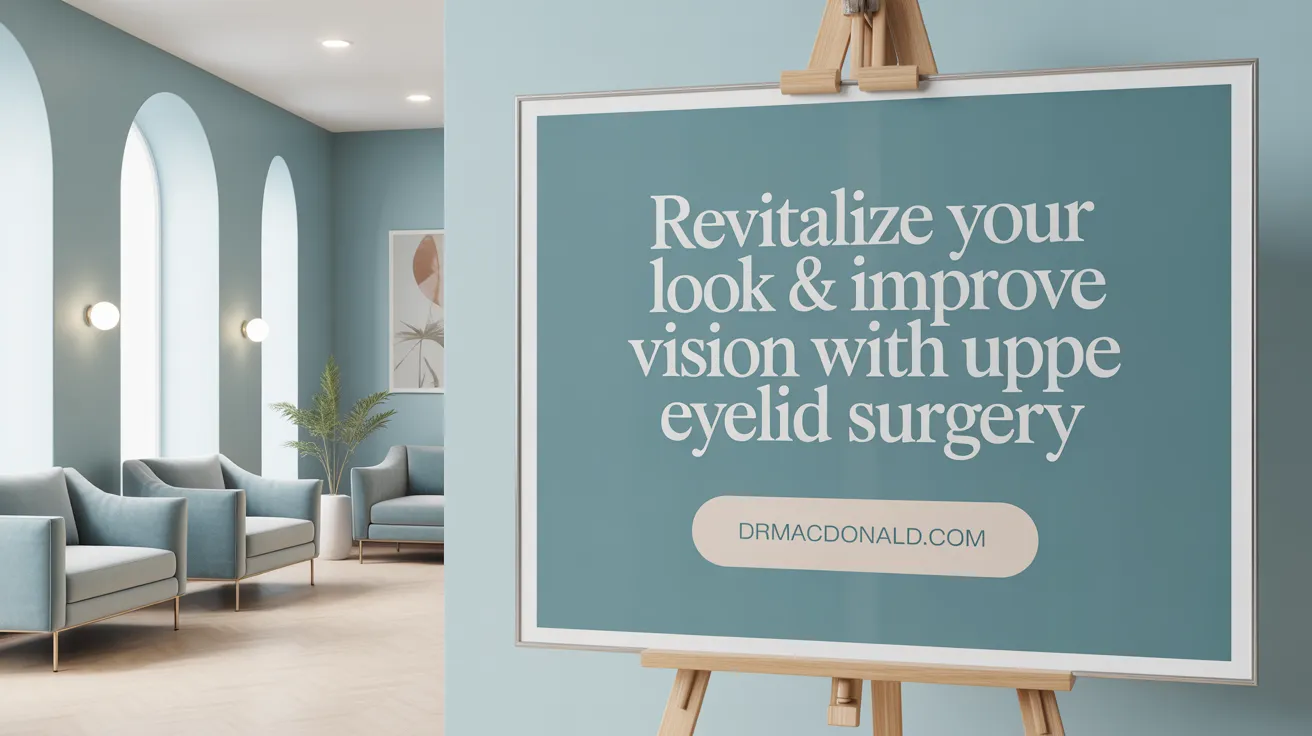Understanding the Differences Between Upper and Lower Eyelid Surgeries
Eyelid surgery, or blepharoplasty, is a popular cosmetic and functional procedure designed to rejuvenate the eye area by addressing sagging skin, puffiness, and droopiness. While both upper and lower eyelid surgeries aim to achieve a refreshed, youthful appearance, they target distinct eyelid concerns and involve different surgical techniques and recovery paths. This article explores the key differences between upper and lower blepharoplasty, highlighting the main goals, procedures, and recovery experiences to help candidates understand what to expect.
Key Facts - Upper and Lower Eyelid Surgery
- Upper eyelid surgery (blepharoplasty) removes excess skin, fat, and muscle to improve appearance and vision.
- The procedure is performed via incisions along natural eyelid creases, with tissue removal or repositioning.
- Surgery duration is typically 30 minutes to an hour under local anesthesia with sedation or general anesthesia.
- Recovery lasts 1-2 weeks with swelling and bruising, sutures removed within a week, and most patients return to activities in 10-14 days.
- Results include more youthful, alert eyes, lasting 5-15 years, influenced by genetics, lifestyle, and aging.
- Risks involve infection, scarring, dry eyes, asymmetry, eyelid malposition, and rare vision loss, minimized by skilled surgeons.
- Insurance may cover if surgery is medically necessary due to impaired vision from drooping eyelids; cosmetic procedures are usually not covered.
- Lower eyelid surgery (blepharoplasty) addresses under-eye bags, puffiness, and wrinkles, using transconjunctival or transcutaneous techniques.
- Lower eyelid surgery takes less than an hour; recovery is 2-3 weeks with swelling and bruising diminishing over time.
- Long-lasting results are common, but aging requires skin care and sun protection; risks include ectropion, scarring, and rare vision changes.
1. Upper Eyelid Surgery: Restoring Vision and Youthful Contours

What is upper eyelid surgery and what does it address?
Upper eyelid surgery, medically known as upper blepharoplasty, is a specialized surgical procedure designed to remove excess skin, fat, and sometimes muscle from the upper eyelids. This operation targets common issues such as upper eyelid sagging correction or drooping eyelids that affect both appearance and function. Functionally, the surgery can improve impaired peripheral vision caused by excess skin hanging over the eyelashes. Cosmetically, it revitalizes the eye area, reducing a tired or aged look and creating a brighter, more youthful appearance.
How is upper eyelid surgery performed?
The surgical technique centers on making precise incisions along the natural creases of the upper eyelids. These incisions are carefully placed to ensure scars remain inconspicuous after healing. Through these incisions, the surgeon removes or repositions excess skin, fat, and muscle to restore a smooth and elastic eyelid contour. The skin edges are then closed with either dissolvable or removable sutures to promote optimal healing with minimal scarring.
What is the procedure duration and anesthesia options?
Upper eyelid blepharoplasty typically takes about 30 minutes to an hour to perform, depending on the extent of correction needed. This procedure is commonly carried out under local anesthesia, sometimes combined with sedation to keep the patient comfortable, though general anesthesia may be used in certain cases.
What does postoperative care and recovery involve?
Recovery from upper eyelid surgery generally lasts one to two weeks. In the immediate days following surgery, patients often experience some swelling and bruising which peak around days 3 to 4 then gradually improve. Postoperative care includes applying cold compresses to reduce swelling, keeping the head elevated especially when sleeping, and avoiding strenuous activities that could exacerbate healing. Sutures are typically removed within the first week if non-dissolvable stitches are used. Most patients feel comfortable returning to public activities within 10 to 14 days, though complete healing and final surgical results may continue to develop over several months.
What are the expected results and how long do they last?
Upper eyelid surgery offers a rejuvenated eye contour, helping the eyes appear more open, rested, and youthful. This can also enhance peripheral vision if it had been limited by drooping eyelid skin. Results are generally long-lasting, with many patients enjoying effects that last between 5 to 15 years. Factors influencing longevity include genetics, skin quality, lifestyle habits like sun protection, and the natural aging process.
What are the common risks and complications?
While upper blepharoplasty is considered safe when performed by experienced surgeons, some risks exist. These include infection, scarring, dry eyes, eyelid asymmetry, difficulty closing the eyes fully, and very rarely, loss of vision. Proper candidate evaluation, careful surgical technique, and adherence to postoperative instructions significantly minimize these complications. For detailed information, see risks of eyelid surgery.
Does insurance cover upper eyelid surgery?
Insurance may cover upper eyelid surgery if it is medically necessary – for example, when sagging skin obstructs vision. Documentation of visual field impairment often supports such claims. Conversely, purely cosmetic procedures without functional impact typically are not covered and must be paid for out of pocket. See more on insurance coverage for functional vs cosmetic eyelid surgery.
| Aspect | Details | Notes |
|---|---|---|
| Purpose | Remove excess skin, fat, muscle from upper eyelids | Addresses vision and cosmetic concerns |
| Surgical Technique | Incisions in natural eyelid creases; tissue removal or reposition | Minimizes visible scarring |
| Procedure Timing | 30 minutes to 1 hour | Varies by individual case |
| Anesthesia Options | Local anesthesia with sedation or general anesthesia | Patient comfort considered |
| Recovery Timeline | 1–2 weeks of swelling, bruising; sutures removed within a week | Return to public after 10–14 days |
| Expected Results | More youthful, alert eyes; improved vision if obstructed | Results last 5–15 years or longer |
| Common Risks | Infection, scarring, dry eyes, asymmetry, rare vision loss | Minimized with skilled surgeon and care |
| Insurance Coverage | Often covered if vision impairment documented | Cosmetic-only procedures generally not covered |
2. Lower Eyelid Surgery: Refreshing the Under-Eye Area and Addressing Puffiness

What does lower eyelid surgery involve and what does it treat?
Lower eyelid surgery, also known as lower blepharoplasty, primarily addresses issues such as under-eye bags, puffiness, wrinkles, and sagging skin beneath the eyes. The procedure aims to remove or reposition excess fat and tighten the skin and muscle in the lower eyelid to create a smoother, more youthful, and rested appearance. It is particularly effective for patients with pronounced fat protrusions or loose skin that contributes to a tired or aged look.
What surgical techniques are used for lower blepharoplasty?
There are two main surgical approaches for lower eyelid surgery:
-
Transconjunctival Approach: This technique involves making an internal incision inside the lower eyelid's pink tissue, allowing removal or repositioning of excess fat without any visible external scars. It is often preferred for younger patients with minimal skin laxity but noticeable fat bulges.
-
Transcutaneous Approach (External Incision): This method utilizes an incision just below the lower lash line, enabling access to remove excess skin, muscle, and fat. It can correct skin laxity and wrinkles in addition to fat protrusion. The incision is carefully placed to minimize visible scarring. Variations include the 'pinch' technique, which removes excess skin without exposing deeper structures.
The choice between these approaches depends on individual patient anatomy, the amount of excess skin, fat distribution, and desired aesthetic outcomes, determined during the surgical consultation.
What is the duration of surgery and anesthesia options?
Lower eyelid blepharoplasty typically takes less than an hour when done alone. When combined with upper eyelid surgery, the total surgery time can extend up to two hours. The procedure is most commonly performed in an outpatient setting.
Anesthesia options include local anesthesia with sedation or general anesthesia, based on the patient's health, surgeon's preference, and procedure extent.
What is the recovery like after lower eyelid surgery?
Recovery after lower eyelid surgery tends to be slightly longer than for upper eyelid blepharoplasty, usually about two to three weeks. Patients commonly experience swelling and bruising around the eyes, with the most intense swelling occurring during the first few days. These symptoms generally diminish significantly within two weeks.
Postoperative care recommendations include:
- Applying cold compresses to reduce swelling during the initial 2-3 days.
- Sleeping with the head elevated.
- Avoiding strenuous activity and heavy lifting for approximately two weeks.
- Following surgeon instructions on cleaning incisions and using prescribed eye drops or ointments.
Suture removal is often required within the first week if external incisions are used; internal sutures may dissolve on their own.
Patients can usually return to work and social activities within 10 to 14 days, although complete healing and scar maturation continue over several months. Final aesthetic results typically become noticeable between 6 to 12 weeks following surgery.
What are the long-term results and maintenance?
The outcomes of lower eyelid surgery are generally long-lasting, with many patients enjoying improvements for many years. Because the procedure removes or repositions excess fat and tightens skin, it effectively reduces puffiness and under-eye bags with results that rarely require repeat surgery.
Aging naturally continues over time, so maintenance via skin care, sun protection, and healthy lifestyle choices is advised to preserve results. Some patients may choose additional non-surgical treatments like laser resurfacing or injectable fillers to complement or extend the benefits.
Are there risks specific to lower eyelid surgery?
Common side effects include temporary swelling, bruising, dry or watery eyes, and mild discomfort. Specific risks include:
- Eyelid malposition such as ectropion (outward turning of the eyelid)
- Scarring or visible incision lines
- Infection
- Rarely, vision changes or other complications
Careful patient evaluation and selection, along with skilled surgical technique, greatly minimize risks. Prompt postoperative follow-up helps identify and manage issues early.
Is lower eyelid surgery usually covered by insurance?
Lower eyelid surgery is generally considered a cosmetic procedure and thus is typically paid out-of-pocket. Insurance coverage for functional vs cosmetic eyelid surgery is rarely provided unless there is a documented functional problem such as impaired vision caused by eyelid abnormalities. Patients interested in insurance coverage should consult with their surgeon and insurance provider to understand specific criteria and documentation requirements.
| Aspect | Details | Notes |
|---|---|---|
| Purpose | Reduce under-eye bags, puffiness, wrinkles, sagging skin | Enhances rested, youthful appearance |
| Techniques | Transconjunctival (internal incision), Transcutaneous (external) | Choice depends on patient’s anatomy and concerns |
| Surgery Duration | Less than 1 hour (alone), up to 2 hours combined | Usually outpatient procedure |
| Anesthesia | Local with sedation or general anesthesia | Depends on procedure and patient |
| Recovery Timeline | 2-3 weeks for swelling/bruising; full healing over months | Return to work in 10-14 days |
| Postoperative Care | Cold compresses, head elevation, activity restriction | Follow surgeon’s instructions |
| Long-term Results | Often lasting years; aging continues | Maintenance includes sun protection & skin care |
| Risks/Complications | Swelling, bruising, dry eyes, ectropion, scarring, infection | Rare vision complications; minimized by skilled surgeons |
| Insurance Coverage | Mainly cosmetic, usually out-of-pocket | Coverage rare except for functional problems |
Balancing Surgical Choice and Recovery Expectations
Choosing between upper and lower eyelid surgery depends on individual concerns ranging from vision impairment to cosmetic goals. Upper blepharoplasty is often pursued for both functional and aesthetic reasons, featuring a relatively swift recovery and potential insurance coverage if vision is affected. Lower blepharoplasty mainly addresses cosmetic issues around puffiness and sagging, requiring slightly longer recuperation and is typically self-funded. Both surgeries can significantly enhance appearance and confidence when performed by skilled surgeons, with recovery protocols aimed to minimize risks and optimize outcomes. Proper patient evaluation, candid consultation, and adherence to postoperative care remain crucial to achieving satisfying, long-lasting results.
